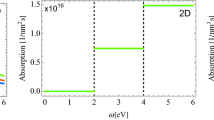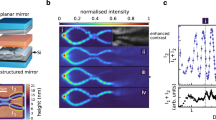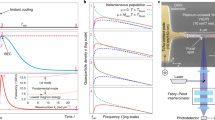Abstract
Bose–Einstein condensation (BEC)—the macroscopic ground-state accumulation of particles with integer spin (bosons) at low temperature and high density—has been observed in several physical systems1,2,3,4,5,6,7,8,9, including cold atomic gases and solid-state quasiparticles. However, the most omnipresent Bose gas, blackbody radiation (radiation in thermal equilibrium with the cavity walls) does not show this phase transition. In such systems photons have a vanishing chemical potential, meaning that their number is not conserved when the temperature of the photon gas is varied10; at low temperatures, photons disappear in the cavity walls instead of occupying the cavity ground state. Theoretical works have considered thermalization processes that conserve photon number (a prerequisite for BEC), involving Compton scattering with a gas of thermal electrons11 or photon–photon scattering in a nonlinear resonator configuration12,13. Number-conserving thermalization was experimentally observed14 for a two-dimensional photon gas in a dye-filled optical microcavity, which acts as a ‘white-wall’ box. Here we report the observation of a Bose–Einstein condensate of photons in this system. The cavity mirrors provide both a confining potential and a non-vanishing effective photon mass, making the system formally equivalent to a two-dimensional gas of trapped, massive bosons. The photons thermalize to the temperature of the dye solution (room temperature) by multiple scattering with the dye molecules. Upon increasing the photon density, we observe the following BEC signatures: the photon energies have a Bose–Einstein distribution with a massively populated ground-state mode on top of a broad thermal wing; the phase transition occurs at the expected photon density and exhibits the predicted dependence on cavity geometry; and the ground-state mode emerges even for a spatially displaced pump spot. The prospects of the observed effects include studies of extremely weakly interacting low-dimensional Bose gases9 and new coherent ultraviolet sources15.
This is a preview of subscription content, access via your institution
Access options
Subscribe to this journal
Receive 51 print issues and online access
$199.00 per year
only $3.90 per issue
Buy this article
- Purchase on Springer Link
- Instant access to full article PDF
Prices may be subject to local taxes which are calculated during checkout




Similar content being viewed by others
References
Einstein, A. Quantentheorie des einatomigen idealen Gases. Zweite Abhandlung. Sitz. ber. Preuss. Akad. Wiss. 1, 3–14 (1925)
Anderson, M. H., Ensher, J. R., Matthews, M. R., Wieman, C. E. & Cornell, E. A. Observation of Bose–Einstein condensation in a dilute atomic vapor. Science 269, 198–201 (1995)
Davis, K. B. et al. Bose-Einstein condensation in a gas of sodium atoms. Phys. Rev. Lett. 75, 3969–3973 (1995)
Bradley, C. C., Sackett, C. A. & Hulet, R. G. Bose-Einstein condensation of lithium: observation of limited condensate number. Phys. Rev. Lett. 78, 985–989 (1997)
Deng, H., Weihs, G., Santori, C., Bloch, J. & Yamamoto, Y. Condensation of semiconductor microcavity exciton polaritons. Science 298, 199–202 (2002)
Kasprzak, J. et al. Bose–Einstein condensation of exciton polaritons. Nature 443, 409–414 (2006)
Balili, R., Hartwell, V., Snoke, D., Pfeiffer, L. & West, K. Bose-Einstein condensation of microcavity polaritons in a trap. Science 316, 1007–1010 (2007)
Demokritov, S. O. et al. Bose-Einstein condensation of quasi-equilibrium magnons at room temperature under pumping. Nature 443, 430–433 (2006)
Griffin, A., Snoke, D. W., Stringari, S., eds. Bose-Einstein Condensation (Cambridge University Press, 1995)
Huang, K. Statistical Mechanics 2nd edn 293–294 (Wiley, 1987)
Zel'dovich, Y. B. & Levich, E. V. Bose condensation and shock waves in photon spectra. Sov. Phys. JETP 28, 1287–1290 (1969)
Chiao, R. Y. Bogoliubov dispersion relation for a ‘photon fluid’: is this a superfluid? Opt. Commun. 179, 157–166 (2000)
Bolda, E. L., Chiao, R. Y. & Zurek, W. H. Dissipative optical flow in a nonlinear Fabry-Pérot cavity. Phys. Rev. Lett. 86, 416–419 (2001)
Klaers, J., Vewinger, F. & Weitz, M. Thermalization of a two-dimensional photonic gas in a ‘white-wall’ photon box. Nature Phys. 6, 512–515 (2010)
Jonkers, J. High power extreme ultra-violet (EUV) light sources for future lithography. Plasma Sources Sci. Technol. 15, S8–S16 (2006)
Siegman, A. E. Lasers (University Science Books, 1986)
Ketterle, W., Durfee, D. S. & Stamper-Kurn, D. M. in Bose–Einstein Condensation in Atomic Gases (eds Inguscio, M., Stringari, S. & Wieman, C. E., ) CXL, 67–176 (Proceedings of the International School of Physics “Enrico Fermi”, IOS Press, 1999)
De Angelis, E., De Martini, F. & Mataloni, P. Microcavity superradiance. J. Opt. B 2, 149–155 (2000)
Yokoyama, H. & Brorson, S. D. Rate equation analysis of microcavity lasers. J. Appl. Phys. 66, 4801–4805 (1989)
Bagnato, V. & Kleppner, D. Bose-Einstein condensation in low-dimensional traps. Phys. Rev. A 44, 7439–7441 (1991)
Mullin, W. J. Bose-Einstein condensation in a harmonic potential. J. Low-Temp. Phys. 106, 615–641 (1997)
Lakowicz, J. R. Principles of Fluorescence Spectroscopy 2nd edn, 6 (Kluwer Academic/Plenum, 1999)
Hadzibabic, Z. & Dalibard, J. Two-dimensional Bose fluids: an atomic physics perspective. Preprint at 〈http://arxiv.org/abs/0912.1490〉 (2009)
Hadzibabic, Z., Krüger, P., Cheneau, M., Battelier, B. & Dalibard, J. Berezinskii–Kosterlitz–Thouless crossover in a trapped atomic gas. Nature 441, 1118–1121 (2006)
De Martini, F. & Jacobovitz, G. R. Anomalous spontaneous–stimulated-decay phase transition and zero-threshold laser action in a microscopic cavity. Phys. Rev. Lett. 60, 1711–1714 (1988)
Yokoyama, H. et al. Controlling spontaneous emission and threshold-less laser oscillation with optical microcavities. Quantum Electron. 24, S245–S272 (1992)
Yamamoto, Y., Machida, S. & Björk, G. Micro-cavity semiconductor lasers with controlled spontaneous emission. Opt. Quantum Electron. 24, S215–S243 (1992)
Kocharovsky, V. V. et al. Fluctuations in ideal and interacting bose–einstein condensates: from the laser phase transition analogy to squeezed states and Bogoliubov quasiparticles. Adv. At. Mol. Opt. Phys. 53, 291–411 (2006)
McCumber, D. E. Einstein relations connecting broadband emission and absorption spectra. Phys. Rev. 136, A954–A957 (1964)
Einstein, A. Zur Quantentheorie der Strahlung. Physik . Zeitschr. 18, 121–128 (1917)
Acknowledgements
We thank J. Dalibard and Y. Castin for discussions. Financial support from the Deutsche Forschungsgemeinschaft within the focused research unit FOR557 is acknowledged. M.W. thanks the IFRAF for support of a guest stay at LKB Paris, where part of the discussion on interacting two-dimensional photon gases was developed.
Author information
Authors and Affiliations
Contributions
J.K. and M.W. contributed to the experimental idea; J.K. carried out the experiments. J.S. contributed to the experimental set-up. All authors analysed the experimental data and discussed the results.
Corresponding author
Ethics declarations
Competing interests
The authors declare no competing financial interests.
Rights and permissions
About this article
Cite this article
Klaers, J., Schmitt, J., Vewinger, F. et al. Bose–Einstein condensation of photons in an optical microcavity. Nature 468, 545–548 (2010). https://doi.org/10.1038/nature09567
Received:
Accepted:
Published:
Issue Date:
DOI: https://doi.org/10.1038/nature09567
This article is cited by
-
Double dome structure of the Bose–Einstein condensation in diluted S = 3/2 quantum magnets
Nature Communications (2023)
-
Interlayer exciton dynamics of transition metal dichalcogenide heterostructures under electric fields
Nano Research (2023)
-
Cosmological mass of the photon and dark energy as its Bose–Einstein condensate in de Sitter space
Indian Journal of Physics (2023)
-
Dispersive and dissipative coupling of photon Bose-Einstein condensates
Communications Physics (2022)
-
Mean-field theory of social laser
Scientific Reports (2022)
Comments
By submitting a comment you agree to abide by our Terms and Community Guidelines. If you find something abusive or that does not comply with our terms or guidelines please flag it as inappropriate.



